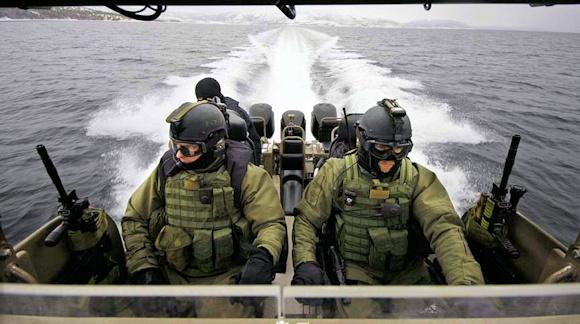The "Inflatable boats", commonly called "dinghies", represent the natural evolution of the old "boat", the first inflatable boat whose propulsion was solely entrusted to the strength of the arms and to one / two oars, essential for maneuverability and to maintain a fixed route. But the real precursor of the current dinghy, as it is now understood, occurred at the beginning of the last century, when a French company that at the time built dirigibili (the then "Ancient Etablissement Maurice Mallet" later became famous with the name of "Zodiac"), having the need to transport bombs and torpedoes alongside the seaplanes, created a new type of vessel consisting of a floating platform, two resistant cylinders of rubberized fabric inflated with air (shaped boat-shaped and applied to the floor same) and a small engine of automotive origin, positioned at the stern, but "off the edge", which guaranteed its propulsion and maneuverability.
This realization in the following years had a huge and unexpected success, affecting many professional sectors and diportistici thanks to both the remarkable progress of chemistry in the field of polyesters and polyamides and thanks to the technological development of the processing of elastomers and fabrics. The dinghy became vessel / boat (depending on the length: "boats" 0-10 mt./"members "10-24 mt.) For search and rescue, for rescue, as emergency equipment / service for a larger boat (tender), for transport and various services, for fishing, for hunting along rivers or in marshes, for camping or nautical excursions, for speed sports or for pure recreational fun.
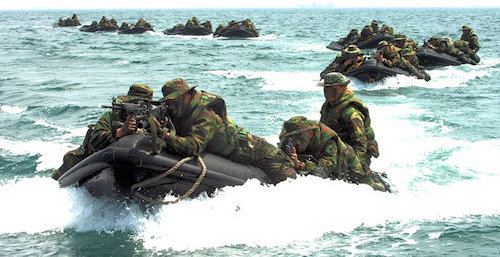 Going now specifically, it should be noted that the initial cylinders of rubberized fabric, then called "tubular", have now become real "waterproof and waterproof" pneumatic systems, with multiple internal sections, with high tear-resistant, anti-cut and impact-resistant qualities. can also provide greater buoyancy and stability to a specific hull. As for the "hull", often improperly called "keel", the modern inflatable boats have 2 different types:
Going now specifically, it should be noted that the initial cylinders of rubberized fabric, then called "tubular", have now become real "waterproof and waterproof" pneumatic systems, with multiple internal sections, with high tear-resistant, anti-cut and impact-resistant qualities. can also provide greater buoyancy and stability to a specific hull. As for the "hull", often improperly called "keel", the modern inflatable boats have 2 different types:
- traditional hull: it is made of a resistant fabric, also called "hull sheet" put on tension on the keel line by means of a partition (which can be pneumatic, plastic or wood) that helps to create the V-shape of the hull same. The hull and the tubulars are "tensioned and placed in shape" on the transverse plane, as well as from the transom, by a floorboard of suitable shape and size (which will act as a walking surface), dismountable into several elements, which gives greater rigidity and compactness to the whole structure. The traditional hull dinghy, once the tubulars have been deflated, once the floor and the transom has been dismantled, can be folded up and fully housed in suitable transport bags;
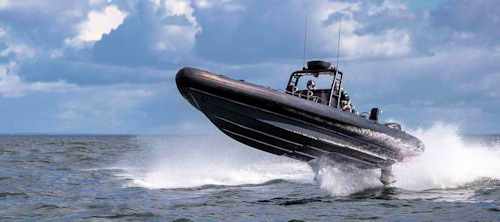 - rigid hull: it is often inappropriately called "semirigida" ... generating then the little marinaresca "semi-rigid keel" that, merged to the tubular ones, would create the so-called "composite boat"; this hull is built with compact materials such as fiberglass or marinated duralumin and has a very pronounced "V" design, with a narrow "deadrise angle", or in any case with angular or "stellate" lines that confer various hydrodynamic advantages.
- rigid hull: it is often inappropriately called "semirigida" ... generating then the little marinaresca "semi-rigid keel" that, merged to the tubular ones, would create the so-called "composite boat"; this hull is built with compact materials such as fiberglass or marinated duralumin and has a very pronounced "V" design, with a narrow "deadrise angle", or in any case with angular or "stellate" lines that confer various hydrodynamic advantages.
The nautical, maritime, nautical or seafaring themes present, by their nature and complexity, topics of encyclopedic scope. For this reason, to provide a correct overview in a few lines it is necessary to adopt a criterion not of approximation but of pragmatic concreteness.
Having said that, it is necessary to point out that both the armed forces and the police forces throughout the world employ inflatable boats with both types of fairing as, as will be seen, a certain number of missions are only achievable by being able to tactically employ a boat with certain characteristics that are strongly linked to the type of hull and all that it allows to do .... permitting.
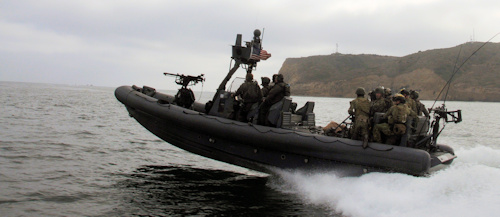 All inflatable boats, regardless of the type of hull, are "planing" hulls, which means that by sailing above a certain threshold speed (called "glide"), part of the hull comes out of the water and the boat proceeds sliding on the water, almost touching it, or "gliding". The glide is guaranteed, in addition to the hydrostatic thrust, also by the hydrodynamic thrust and for this reason the gliding boat is strongly influenced by the weight and therefore by the overall load (including the number of men and their armament). The glide, combined with a hull shape and powerful engines, ensures the boat reaches high speeds. Below the gliding speed, the dinghy clearly navigates "in displacement", that is, it advances moving the water it encounters, from bow to stern, exactly like a ship does.
All inflatable boats, regardless of the type of hull, are "planing" hulls, which means that by sailing above a certain threshold speed (called "glide"), part of the hull comes out of the water and the boat proceeds sliding on the water, almost touching it, or "gliding". The glide is guaranteed, in addition to the hydrostatic thrust, also by the hydrodynamic thrust and for this reason the gliding boat is strongly influenced by the weight and therefore by the overall load (including the number of men and their armament). The glide, combined with a hull shape and powerful engines, ensures the boat reaches high speeds. Below the gliding speed, the dinghy clearly navigates "in displacement", that is, it advances moving the water it encounters, from bow to stern, exactly like a ship does.
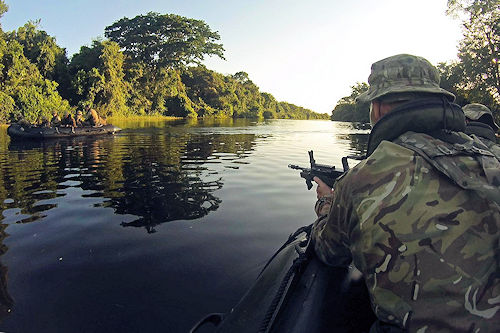
The inflatable boats are a very versatile, flexible and fast operating tool. Obviously not being able to have specific boats for each individual mission assigned, we must on average implement a "compromise", both operational and tactical, and the inflatable boat lends itself well to any "reconfigurations", in addition the operational versatility also resides in the fact that the transport can be carried out at long range with aircraft (aviolancio), intermediate radius with helicopters (heliport) or by sea with naval units (seagoing and recovery by special cranes, slides or aft ramps) or submersibles (with the use of special shelters) or overland using special trolleys or equipped containers.
The military dinghies have no rudder as they mainly employ outboard or sterndrive engines (where the engine foot and propeller act as a rudder) or hydrojet (also without rudder) and are classified into only two categories, depending on the type of hull as, as already mentioned, the type of hull strongly binds the sector of operational use:
CRRC: Combat Rubber Raiding Craft / Combat Rubber Reconnaissance Craft (traditional hull);
the RHIB / RIB: Rigid Hull Inflatable Boat / Rigid Inflatable Boat (rigid hull).
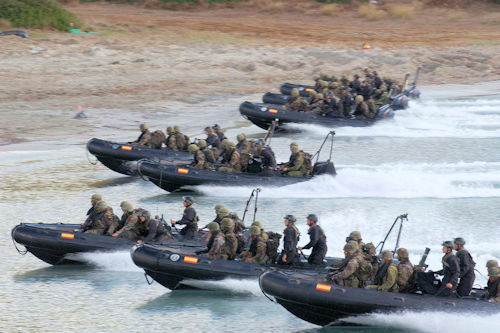
The CRRCs are traditional hull inflatable boats and can have a length that, in principle, goes from 3 to 6 meters. Given the size and space available, generally employ only one outboard motor, bar, fueled with petrol up to 40 / 60 hp (with a possible additional minor engine for emergency). They load one or more removable tanks and, depending on the load, can have a range of several tens of miles with a maximum speed that can be circumvented around the 20 / 25 nodes. They can embark on average up to 6 men in full combat order ... sometimes, in some configurations and depending on the maximum load possibilities, also 8. In case of need of silent navigation or near the lens or in the presence of shallow water, the engine can be turned off and partially lifted by the water, thus allowing the continuation of the mission with the exclusive use of paddle oars. In case of disembarkation, stranding or grounding, due to the possibility of their deflation and total dismantling, if necessary, they can also be easily camouflaged, concealed or buried. In light of their characteristics, they can be used in the following operational activities: occult mobility and reconnaissance, observation and collection of information, troop transport, release and recovery of operators, infiltration and exfiltration, penetration and leakage in enemy areas, activities of mining, unused explosive devices, pre-assault amphibious and disembarkation operations, amphibious handshakes, raids and sabotage.
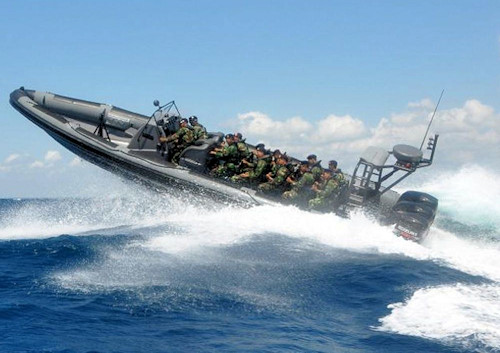
The RHIB / RIB rigid rigid hulls can have a length that, in principle, goes from 5 to 15 meters. Depending on the configuration required by the specific mission, they can embark up to 18 men in full combat set-up (some configurations foresee 2 / 3 "crew" men dedicated only to maneuvering and navigating). Given the size, these boats, to optimize the hydrodynamic yield of glide, need more engine and therefore have fixed tanks (fuel tanks), and any additional tanks, to power marine outboard engines (petrol) or Sterndrive (petrol or diesel) or hydrojet inboard (diesel). The outboard engines, which in case of serious failures are more easily replaceable, are often used in "stern drives" of 2,3,4 or more engines (called "multiple drive") that require different devices for their synchronic use and their correct and mutual positioning to avoid cavitation problems. The increase in the number of engines increases the performance in terms of available power (but not proportionally in terms of maximum speed!) And allows greater recovery and greater acceleration. An excellent configuration can already be obtained with two engines from 115, 150 or 300 cv, with counter-rotating propellers outwards, configuration that allows to provide the commonly optimal performance expected for an RHIB, or have an autonomy, at full load, of hundreds of miles at speeds even over 50 nodes. Such a dinghy requires, for both the maneuver and for the control and the navigation control, a special console / platform with the wheel of the rudder, the lever for the control of the engines with a trim button (system that helps to glide in case of sea size) and where are present, as well as the compass, also the controls and displays of various instruments (radio, navigation radar, GPS, depth sounder, log ...). 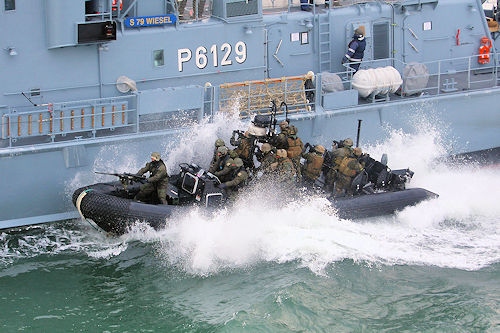 The boat has, in several versions, also a robust "roll-bar" support bar (reversed "U" bar) used to support radar antennas, radios, projection lights and lights. Panels or closed ballistic protection structures can be mounted as well as bases or supports (tripod or carriage) to override machine guns of different calibres (5.56x45mm.-7.62x51mm.-12.7x99mm.) Or grenade-launching machine guns (cal.40x53mm.). Many RHIB tend to have pneumatic tubulars no longer inflated with air but filled with special foam or hardening resins so as to guarantee the buoyancy of the vessel even in case of impact / perforation by bullets or splinters: in this case they assume the words RHIB-FFRHB (Foam Filled Rigid Hull Boat). In light of their high speed characteristics (they can get close to the target without the enemy having the perception of the attack already in progress), stability in gliding, lateral stability in turn, load capacity, possibility of armament, resistance of the hull (in case of rough sea the tubulars can withstand the violent impacts against the ship's sides) and kept at sea, the RHIB can be used in the following operational activities: troop transport, coastal and fluvial patrolling, armed reconnaissance, interception rapid, tracking and attack, area interdiction operations, amphibious operations, maritime security operations (in particular: Boarding / VBSS boarding operations: Visit, Board, Search, Seizure).
The boat has, in several versions, also a robust "roll-bar" support bar (reversed "U" bar) used to support radar antennas, radios, projection lights and lights. Panels or closed ballistic protection structures can be mounted as well as bases or supports (tripod or carriage) to override machine guns of different calibres (5.56x45mm.-7.62x51mm.-12.7x99mm.) Or grenade-launching machine guns (cal.40x53mm.). Many RHIB tend to have pneumatic tubulars no longer inflated with air but filled with special foam or hardening resins so as to guarantee the buoyancy of the vessel even in case of impact / perforation by bullets or splinters: in this case they assume the words RHIB-FFRHB (Foam Filled Rigid Hull Boat). In light of their high speed characteristics (they can get close to the target without the enemy having the perception of the attack already in progress), stability in gliding, lateral stability in turn, load capacity, possibility of armament, resistance of the hull (in case of rough sea the tubulars can withstand the violent impacts against the ship's sides) and kept at sea, the RHIB can be used in the following operational activities: troop transport, coastal and fluvial patrolling, armed reconnaissance, interception rapid, tracking and attack, area interdiction operations, amphibious operations, maritime security operations (in particular: Boarding / VBSS boarding operations: Visit, Board, Search, Seizure).
 Within the scope of all the possible configuration variables that we can make to a dinghy to perform the assigned mission, the fact remains that we will only do what the sea will allow us to do.
Within the scope of all the possible configuration variables that we can make to a dinghy to perform the assigned mission, the fact remains that we will only do what the sea will allow us to do.
Marco Bandioli (photo)

